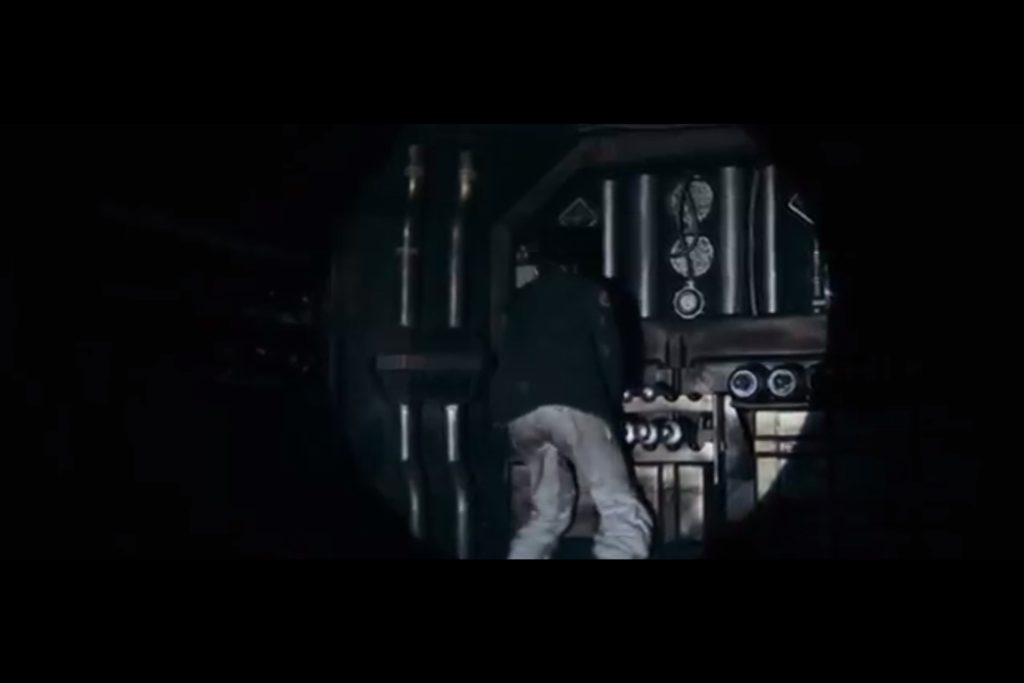Alien (1979)
Plot: Fighting the Xenomorph
Alien is about a spaceship returning home, but on its way an aggressive and hostile alien infiltrates the ship and aims to destroy every human being on board. The film is set in 2122 and the Nostromo is on its way back to earth, delivering resources. There are seven crew members sleeping, but suddenly the ship’s AI, called Mother, wakes them up. They receive a transmission from a nearby planet, so three of the crew members investigate an abandoned vessel they discover on said planet. Soon, one of the members, Kane discovers what seem to be eggs. Before he can investigate them any further, one of them hatches and something grasps his helmet. Ripley, played by Sigourney Weaver, denies them entrance and demands quarantine, but Ash, the doctor on board, opens the hatch anyway. The creature connected itself to Kane’s head and cannot be removed without killing him as it feeds him oxygen and sprays acid when harmed. Miraculously, Kane recovers soon and the creature is thought to be dead. Ash and Captain Dallas attempt to analyse the creature, but cannot find much except a shell. During dinner, Kane’s thorax explodes and the alien escapes from his body. The alien evolves and becomes a hunter that kills all the crew members, who attempt to find and kill it. Captain Dallas, for instance, is killed after entering a ventilation shaft and using a flamethrower to terminate the alien. Afterwards, Ripley becomes the commanding officer and is now authorised to communicate with Mother. She uncovers the true reason for their journey and the order to find and protect the specimen and to expend the crew, if necessary. Ash, who turns out to be an android sent by the mysterious corporation that invented Mother and assigned the journey’s purpose, attempts to kill her, but fails. After all her colleagues have died, Ripley uses the self-destruction mechanism in order to destroy the ship and the alien. However, the alien is on board of her safety vessel, but can eventually be pushed out by decompression.
Although Alien was written by men (Dan O’Bannon and Ronald Shusett) and directed by another man (Ridley Scott), the film depicts a female protagonist, reacting to contemporary shifts towards feminism and the empowerment of women in previously male-dominated spheres. She is the only one capable of surviving the xenomorph’s attacks. Here, the trope of a female soldier and scientist succeeding correlates with viewpoints on feminism at that time. In spite of this seemingly progressive idea, the last scene shows her undressing and fighting the alien in underwear – something many scholars have argued about.
The Vietnam War ended in 1975 and can be considered to be one of the influences and, according to Burling, likely has affected Alien’s anti-capitalist notion that portrays an opaque corporation as the secondary antagonist in the film. “Scott’s use of corporate antagonists makes his critique clear even to viewers who were more taken with, say, Alien’s meditation on gender and reproduction” (Decker 75). The corporation and its intentions pose a warning of a capitalist future, which can be found in other films of the franchise, too: “[Scott] uses the Weyland-Yutani […] corporation not only to critique contemporary capitalism but also to help delineate the place of corporations and corporate leaders in industrial society” (Decker 76). In giving the corporation power over the ship’s AI and hence the crew member’s lives, Scott alludes to the lack of autonomy connected to the gain of power of corporate leaders. The corporation is personified by Ash, the android that has disguised itself in order to bring the alien on board of the Nostromo and later attempts to murder Ripley as she discovers his secret agenda.
As this chapter has shown, the plot of Alien provides allegories for its political and cultural context and even allows for social commentary. “Despite its derivative plot, the film is an intelligent meditation on the nature of power relationships under capitalism, the commercial expendability of the individual, and the alienating consequences of functional specialization” (Wright 93). There is a distortion of order that needs to be restored, moral values need to be reaffirmed (see Knight & McKnight 91) and this is what the plot’s purpose is: offering a scenario in which humanity is threatened by an alien life form and use it as a metaphor for contemporary development and criticism. The plot is not the only part of the film that addresses questions like these, as the next chapter shows.
Themes and Images: A Female Commander on a Dark Ship
Ridley Scott does not rely on the plot of his film in order to convey his message. In addition to the story, images and sound support the meaning of the film or even add new layers to it. This chapter elaborates on this notion of cinematographic elements that further highlight Alien’s status as a film affected by its context.
According to various scholars, the alien itself symbolises sexism and racism, thus, the film offers a metaphorical catharsis or fight against hegemony.
In science fiction, the ‘other’ as ‘alien’ is deployed to concretise the deeply divisive dichotomies of race and gender embedded in the repressive structures and relations of dominance and subordination. Modernity remains intact, the moral guardian of the future, whilst the ‘other’ emerges demonised and thus can be justifiably annihilated. (Mair 35)
This dichotomy becomes evident when one analyses the colours and textures that have been used to distinguish the alien from humans. I already mentioned that the xenomorph is black, but there are more scenes that demonstrate this issue. The first scene that shows the crew members resembles birth. The room is well-lit and everything is white, the characters are barely clothed (see fig. 1). Every other room associated with humans, the kitchen for instance, is also white and bright. In contrast to that, the alien ship is black, dark, and mechanical. There are leathery eggs and slime. Contrary to the peaceful awakening of the crew members, the initial birth of the alien (the egg hatching) is forceful and induced by Kane.
Fig. 1: Rebirth. Alien. Directed by Ridley Scott. Twentieth Century Fox, 1979: 00:06:10.
Besides colour-coding, there is phallic imagery used as “source of horror and disgust” (Wright 93). I argue, however, that it is not only phallic imagery that makes the alien’s appearance so disturbing. It is rather the use of these images in the context of the film and the associations it provokes. H. R. Giger, who initially developed the alien, implemented biomechanical, surreal and visceral elements. The look and the alien’s behaviour address stereotypically masculine fears and desires, like penetration (see Cranny 236). This becomes evident after the arrival of the alien on board. The alien clings to Kane’s face and puts a tail-like limb down his throat (see fig. 2).
Fig. 2: Alien in Throat. Alien. Directed by Ridley Scott. Twentieth Century Fox, 1979: 00:36:52.
However, as we see in later scenes, the alien does not distinguish between male and female victims and therefore reveals “normative […] gender coding of familiar narratives” (Cranny 237), pointing towards a gendered bias seen in other science fiction or horror films. Barbara Creed provides another perspective on gender issues in Alien. She explains that the alien is a “phallic mother” (Creed 51) and the ship, womb-like and called “Mother”, another entity, both representing a kind of woman that is not desired. “The concept of the parthenogenetic, archaic mother adds another dimension to the maternal figure and presents us with a new way of understanding how patriarchal ideology works to deny the “difference” of woman in her cinematic representation” (Creed 44). Consequently, the final scene represents the counterpart and reassures conservative ideas, as explained earlier. Ripley undresses, but her escape is interrupted when she discovers that the alien is on board of the same vessel. “Compared to the horrific sight of the alien as fetish object of the monstrous-feminine, Ripley’s body is pleasurable and reassuring to look at. She signifies the “acceptable” form and shape of woman” (Creed 52).
Indeed, the filmmaker’s intention was to provide disturbing imagery constructed to aim at people’s attitude towards sex and the twisted and gender biased perception films usually offer. Moreover, the aim was to attack male audience primarily (Dietle 2011) and to eradicate stereotypes, suggesting an alternative and indicate the industry’s one-dimensional depiction of women. Linda Williams argues that this is an important function the science fiction or horror film serves: subverting expectations and changing people’s viewing habits. She names Psycho as one of the first films to achieve this (Williams 78). A further way to subvert expectations and make the viewers think about the film is the use of the uncanny.
The uncanny body was a modality. Its appearance marked a shift in a viewer’s perception of the space, sounds, rhythms, bodies, acting gestures, and spoken language in film. […] It might be called up by a voice suddenly sounding reedy or booming, a cut to a close view, an audible pop accompanying a film edit, or a combination of these events. Also, this shift, […] reorganized a viewer’s experience of a film. It provoked a change in the movie’s “emotional ‘weather, ’” effecting a transition into a more deeply dreamlike state – although in the case of the uncanny body, this state was closer to a nightmare than to an enchanting reverie. (Spadoni 29)
The alien can be considered an uncanny body, embodying threat and contaminating previously safe spaces in the ship. The most important example is the alien’s rebirth from Kane’s body (see fig. 3). Kane’s subsequent death is shocking for multiple reasons. First, the alien seems to be dead, so its reappearance is as shocking as threatening. The reactions to the incident differ – while Ripley wants to keep the alien outside their ship, Ash wants to investigate the lifeform and Kane’s body, but Parker is determined to kill it. The composition in this image foreshadows future events: the crew stands on one side of the table, acting like a unit, but Ash, who acts contrary to their goals, stands on the other side of the table.
Fig. 3: The crew standing around Kane’s body. Alien. Directed by Ridley Scott. Twentieth Century Fox, 1979: 00:56:49.
Another reason for the shocking notion of this scene is that the alien is an intruder to the safe space. It stayed hidden inside a body of someone the crew deemed trustworthy and attacked them where they thought themselves safe. This “alienation of the familiar” (Sobchak 107) and “dehumanization of humans” (Sobchak 120) is what Vivian Sobchack regards as exceptionally subverting: “While we may react with varying degrees of detached wonder to invading Martians […] who are distinctly seen as “other” than ourselves, our responses to those aliens clothed in our own familiar skins are another matter entirely” (120). The invasion of a safe space is one way to depict the alien and evoke a sense of danger. In terms of its outer appearance, the alien’s non-human features are exaggerated: teeth, tail, its second head inside its mouth are often shown, but the camera focuses on these features and on close-ups. Often, the creature is not in focus, letting the viewer’s imagination fill in the blanks and thus creating suspense with invisibility. Scott explains that the imagination and thinking to have seen something rather than actually seeing it is more frightening and horrific (de Lauzirika 01:08:19). The film uses invisibility as a stylistic device to achieve horror.
Fig. 4: Alien approaches Lambert in the light. Alien. Directed by Ridley Scott. Twentieth Century Fox, 1979: 01:32:21.
One particular scene shows how the cinematic elements of the film foreshadow events and create tension without actually showing the alien. While gathering ammunition to eliminate the creature, Lambert is shown in the dark. She suddenly moves until a beam of light is placed in such a manner that she is presented as a target (see fig. 4). In the middle of the light, exposed to everything that comes from the dark, she quickly realises her situation, but does not manage to escape the alien. This scene also exemplifies the way in which Alien uses lighting, composition and colour-coding to add layers to the film.
Furthermore, there is sound, not only complementing the imagery, but affecting the audience and creating an additional layer of meaning beyond the visual experience that aims to shift the audience’s perception towards the filmmaker’s vision. It is all about plausibility and authenticity (see Preuß 40). The more grotesque and preposterous the alien and its noises are, the more vicious and misanthropic do its attitude and intentions appear (see Preuß 43). Yet, it is important to maintain a balance between something that sounds unfamiliar, but also familiar enough so that the audience can determine emotions in its voice (see Preuß 46). These sounds are missing in Alien and the xenomorph does not make any sounds that indicate its intentions. This noiselessness, like invisibility, make the creature more threatening and make it difficult for the characters and audience alike to identify their opponent.
As this chapter has shown, Alien uses various cinematographic elements to add meaning to the film. Besides colour-coding to distinguish between alien and human and the almost complete lack of diegetic sound and footage of the alien, the film uses distinct imagery to point towards gender issues that have been discussed in the previous chapter. Following this idea, the alien could be a metaphor for feminism, for feminist movements peaked in the 1970s. The potentially harmful or potentially beneficial characteristics of the alien could represent the prejudices feminist movements faced. Hence, Alien does not only depict biases and stereotypes that were prominent at the time, but perhaps comments on them.




